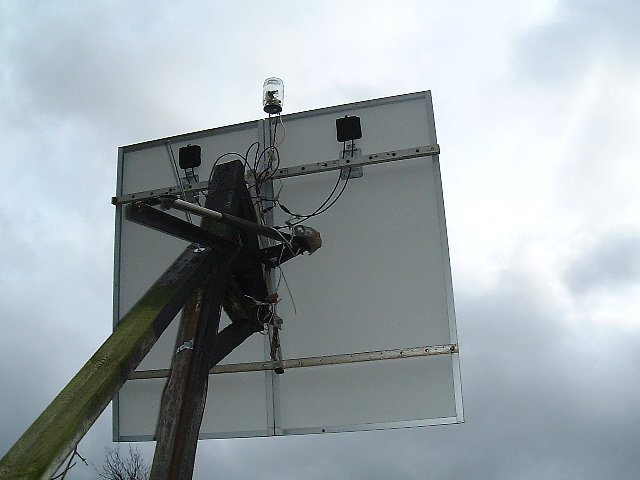Hi folks,
Reading trackerJacks' post, I thought I'd post m own DIY tracker. I can't claim it to be original as the inspiration came from the redroc unit, but it works, it's simple, and it's been up and running since November 2009.
Besides, it's about time a contributed something to this forum as I've been sponging ideas off here for a couple of years.

.

This is the circuit diagram (hand drawn and poorly photographed, sorry). Basically two 5mm high-brightness red LED's positioned 45° east and west of the panel (and mounted so they turn with the panel) are wired in opposition.As long as they are seeing about the same amount of light the output from the opamp is about B+/2. If your using LED's as photosensors use reds - as you go through the spectrum from red to blue the signal you get out of them goes down.
the 1st op-amp is used as a high-gain low-pass amplifier. I used a 10Mohm feedback resistor but with hindsight I'd probably have used 1M or 3.3M. There's also a small capacitor (10nF) in parallel with the feedback resistor (but not marked on the circuit diagram). The op-amp is probably an LM301 or LF351 as I had a few of these lying about at the time.
The other four op-amps are used as comparators and are an LM324. the first comparator goes high if the signal exceeds the threshold set by trimmer pots. the output charges a capacitor via a resistor; I can't remember what value, but it was the highest value which didn't stop the capacitor from reaching the threshold of the next comparator. The resistor determines the time delay before the panel moves - to stop it chasing clouds across the sky. When the capacitor reaches B+/2 then the next comparator goes high operating the relay and driving the panel until the signal from the amp falls below the threshhold again. As the relays are 1600 ohm the LM324 can drive them directly.
Another thing missing from the diagram are the limit switches - these are microswitches wired normally closed and in series with the relay coils.
It worked OK in this configuration except that if the panel was all the way over to the west from day before,when the sun came up in the morning it could take a couple of hours to work out that the sun was behind it, so I modified it with 4 extra LEDs; two pointing 90° east and west,and two at 135°. it's been working for a year in this configuration and can find the sun as soon as it clears the trees / comes out. On bright overcast days it turns to face the open sky (i.e. about south). on very dull days it doesn't react.
There are some minor issues with it as it stands:-
The 10Mohm feedback it too high - even with the trimmers set to minimum sensitivity it reacts on days when the gains of moving less than marginal.
The delay provided by the RC network is only about 1min - too short - and occasionally it does chase bright clouds across the sky.

I'm running it directly off battery voltage - 24V. the datasheet states that the max operating voltage for an LM324 is 28v so occasionally I exceed this; not had any problems yet though.

Here's the actual solar panel and mount:

If your wondering (if you can tell from these pics) why it's cobbled together from a random mix of wood, angle iron and aluminium extrusion - it's because that's what I had lying around. The panels are Unisolar ES64's. The actuator I got off eBay - 24v 500mm 2000N (~450lbs?). It coped with the winter winds (2009 & 2010) OK (this site's got high hedges all around).

The electronics are in the pickled-onion jar.

This January I added a pair of 80W monocrystallines

- and no, I'm not sure the mount can handle the wind loading; though it's managed so far, if any extreme winds are forecast I may tie a couple of ropes to it for the duration.
Hope it all makes sense - sorry my documentation is a bit lacking.
mab